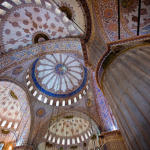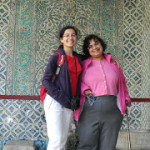 |
| Blue Mosque interior |
Sailing Back from Byzantium
 |
| Byzantine Art in the Church of Our Saviour at Chora
Sailing Back from Byzantium
Back home from a week in Istanbul (Byzantium/Constantinople).
The vanished Kingdom of Byzantium is best celebrated in Yeats’ beautiful poem, “Sailing to Byzantium.”
THAT is no country for old men. The young
In one another’s arms, birds in the trees
– Those dying generations – at their song,
The salmon-falls, the mackerel-crowded seas,
Fish, flesh, or fowl, commend all summer long
Whatever is begotten, born, and dies.
Caught in that sensual music all neglect
Monuments of unageing intellect.
An aged man is but a paltry thing,
A tattered coat upon a stick, unless
Soul clap its hands and sing, and louder sing
For every tatter in its mortal dress,
Nor is there singing school but studying
Monuments of its own magnificence;
And therefore I have sailed the seas and come
To the holy city of Byzantium.
O sages standing in God’s holy fire
As in the gold mosaic of a wall,
Come from the holy fire, perne in a gyre,
And be the singing-masters of my soul.
Consume my heart away; sick with desire
And fastened to a dying animal
It knows not what it is; and gather me
Into the artifice of eternity.
Once out of nature I shall never take
My bodily form from any natural thing,
But such a form as Grecian goldsmiths make
Of hammered gold and gold enamelling
To keep a drowsy Emperor awake;
Or set upon a golden bough to sing
To lords and ladies of Byzantium
Of what is past, or passing, or to come.
Byzantium of course no longer exists. It was destroyed by the Crusaders in 1204. One of them leaves an account of The Great Palace of the Byzantine Emperors,
“Within the Palace, there were fully 500 halls, all connected with one another, and all made with gold mosaic. And in it were fully 30 chapels, great and small, and one called the Holy Chapel, which was so rich and noble that there was not a hinge or band that was not all of silver, and there was no column that was not of jasper or porphyry or some other precious stone.”
By the time, the crusaders left the Palace it was virtually destroyed, and the old Byzantium is now best seen in Ravenna which we visited last year, the lovely mosaics constructed by craftsmen sent from Byzantium.
And now, I am so enjoying my regular life of reading and writing and reading Scripture and praying (and other things besides). It is a bit intense, and I felt the need of a break, and the best part of travel is that it makes the life you left behind seem doubly sweet on your return.
|
An Istanbul Must See — The Topkapi Palace, the Former Center of Ottoman of Power
| Irene tiptoeing to be taller than her mother. |
The star attraction of Topkapi is the harem. Here is the first decorated room in the harem. Our response was “Wow, definitely worth the extra admission charge.” The self guided tour is organised so that each section is more impressive than the previous, so you are always saying “Why did we spend so log on the beginning” and never “Oh, just another room.”
An exterior passageway
The palace was destroyed by two great fires, so perhaps it is OK to spoil a photo with a fire extinguisher.
A single tile
A single tile from the wall above.
A couple of border tiles
A lovely geometric pattern on the wall
Closer sinspection reveals the details (for some reason it looks green from a ditance)
and here is a single hexagonal tile
The Queen Mother’s apartment is the grandest living area in the women’s area. The room, tiles from floor to ceiling has a fireplace, and cupboards.
Here is the ceiling of another room in her apartement
and Irene photographing it
Inlaid mother-of-pear cabinet
| detail |
A border
Harem comes from the Arabic (ḥaram) ‘something prohibited; sanctuary, women’. Most of the Harem is enclosed, wit few windows. We are outside again, in a courtyard.
The walls under the arches are tiled
A wall by the Sultan’s chamber
and a close up
The Sultan’s chamber. Naturally the largest and grandest room, but actually, the crown prince’s rooms, being smaller have a greater intensity of decoration.
An alcove with three shelves (still in the sultan’s chamber)
Half the ceiling and the top of a wall (sky lights in the very center)
A couple of details of the painted arches
Corner of sultan’s chamber
In the next room, a water tap for ritual washing
detail
More decorated alcoves
Next we move to a remarkably beautiful room, that seemd to be just the meeting place for two corridors. Ceiling and top of the walls
Five shots of a truly beautiful wall — I will have to find more pics of it
One of the two crown prince’s rooms.
Top of the wall
Detail
Further refined
| This incredibly detailed work is about 10 feet up — well above eye level! |
The crown prince’s room was well endowed with windows, but visitors can only access part of the room, hence the angled shots.
Gilded alchoves
What looks like the tree of life.
This looks like a carpet made of tiles. (This needs to be straightened, but Picassa’s straighten tool loses resolution.)
Rhe top of the wall and a little of the ceiling
The ceiling
A brillliant panel in a narrow passage bewteen two rooms
Outside, again. The outside of the crown prince’s rooms
Still no expense spared. Notice the tiling between the windows, and the gilded decoration on the eaves.
| Gilded decoration on the eaves |
| Tiling at the base of the wall |
A long tiled wall
and it’s time for a very late and well deserved lunch at the restaurant overlooking the Bosphorus
There is lot more to Topkapi. Here is the Sultan’s library — a large bright airy pavilion in the gardens
The divan and Hall of state
| Entrance to hall of state |
| A corner of the Hall of state |
| Detail of an archway in the Hall of State |
A couple of tulips
It was a beautiful day
A final glimpse of the Blue Mosque on the way out.
Nothing is Impossible With God
John hears Jesus’s last words. He sees Jesus absolutely dead, blood and water issuing from his heart. He goes to bed, I imagine, shattered beyond grief—rent with the horror and guilt and unimaginable agony I would feel if I saw that happen to my husband or father or child. Talk of post-traumatic stress!
and increases the power of the weak.
30 Even youths grow tired and weary,
and young men stumble and fall;
31 but those who hope in the LORD
will renew their strength.
They will soar on wings like eagles;
they will run and not grow weary,
they will walk and not be faint. (Isaiah 40)
In which areas do you find faith easy–or hard? What are your limps and thorns?
My Teenage Rebellion: Trying to become a Nun at Mother Teresa’s Convent!

I have written about the experience here, A Teenage Atheist, and here, The Holy Ground of Kalighat.
Matt of The Church of No People recently asked me some questions about my experience, and I thought I would share them here. The questions in bold are Matt’s.
The Bosphorus Cruise–in the narrow strait between Europe and Asia!!
We went on one of the world’s most unique cruises today–the Bosphorus Cruise: Europe on one side of the narrow strait, Asia on the other. Seagulls haunting the strait, dolphins leaping, the Black Sea at one end, the Sea of Marmara on the other–and fantastic mosques, palaces, summer houses and churches on either side of the Bosphorus.
I loved it–it’s where I live, metaphorically, between Europe and Asia. Am totally at home in Europe after almost 3 decades in the West, and at home in Asia too (though, oddly, less so). What a fantastic, and beautiful conjunction of my two worlds!
And sitting watching the amazing, almost surreal panorama of palaces, mansions, summer houses, mosques and churches go by while seagulls wheeled and screeched–I was purely happy.
And thank you to Roy for writing the rest of this post, and giving me a fighting chance of keeping up with my blog on holiday:-)
The Bosphorus Cruise begins at the Galata Bridge.
and river front homes
The Blue Mosque in Istanbul
The Blue Mosque in Istanbul
And I am thankful to my husband, Roy for the photos and the commentary in the rest of this post!
| View of the Blue Mosque from just inside the courtyard. The banners give extracts from the courtyard that are likely to appeal to all. e.g, Pay the worker his wage before his sweat dries |
| Entrance to the outer courtyard |
| detail |
| Ceiling design |
| Ceiling design |
| Arcade along one side of the outer courtyard |
| The tulip did of course originate in Turkey. |
| Blue tiles on the upper gallery wall — note the carved railing. |
| Blue tiles on the top of pillar. |
Tweet
Perhaps heaven will look a little like the Hagia Sophia in Istanbul


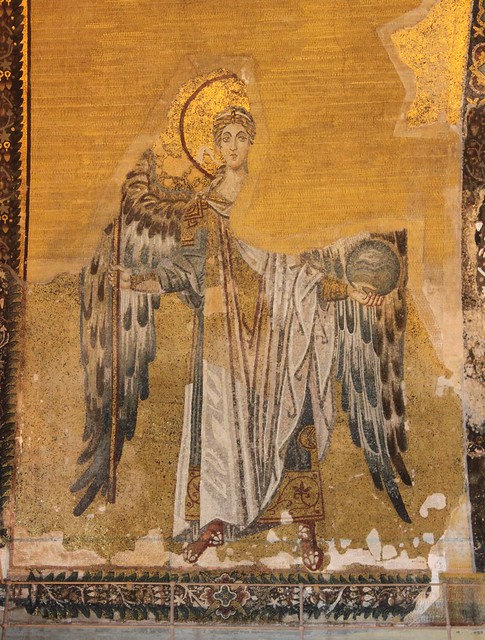
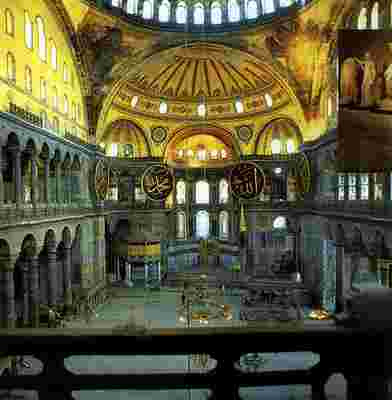
| The inner most circle in the central dome of Haghia Sophia |
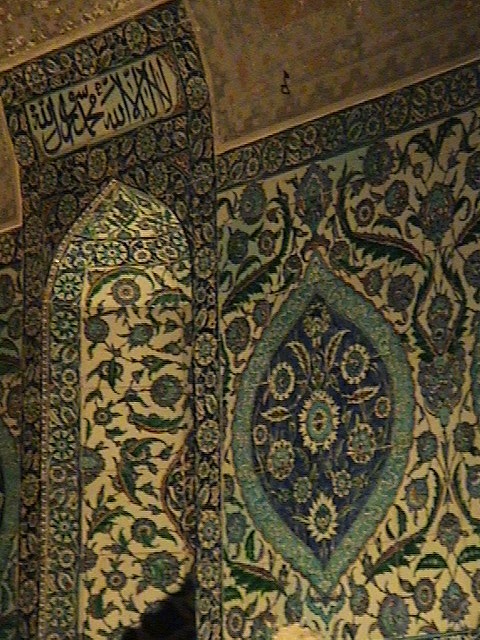
- « Previous Page
- 1
- …
- 20
- 21
- 22
- 23
- 24
- …
- 121
- Next Page »
